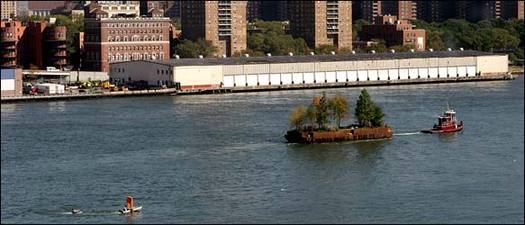This also goes on my Lists Of Things 'We' Did Not Know In 2008 and 2007, Which Is When James Wagner Mentioned It.
I admit, I largely pulled back from the whole Bruce High Quality Foundation hype when it, well, when it started feeling like trendy hype. Nothing courts fame like courting anonymity. So I missed the reference on AFC last summer to BHQF chasing Smithson's posthumously realized Floating Island with The Gate. And I missed their interview in Art In America last spring where they discussed doing the project before they even had their brand. And I missed James's mention of it way back in 2007, too.
Ironically, tracking down the anonymous artists behind one of the most supremely perfect public art gestures of the decade was actually on my list of things to do in 2010. I assumed I'd get word to them through Redhead, the gallery at the LMCC, where they showed the The Gate: Not the Idea of the Thing But the Thing Itself later in fall 2005. So I guess I can check it off.
But while I obviously have to relook at BHQF's subsequent projects in a less reflexively cynical light, I kind of feel the need to re-evaluate The Gate, too. Take their entire approach to fiction, which they discuss in AiA:
BHQF: We believe in the liberating properties of fiction. The whole fictional awning of The Bruce High Quality Foundation is not supposed to be about obfuscation. It's about framing things in a way that we feel is more accurate-even if it's steeped in fiction-towards a model we're trying to engage here.And then look at how they describe The Gate's serendipitous impact on their website:...
When there are moments of clear misinformation, those are generally used to make people be more conscious of the potential that it's all made up. They have a function so that you always know it has been written by someone somewhere.
In keeping with its institutional policy of doing extra-institutional interventions, and at a cost of 2,000 dollars, The Bruce High Quality Foundation set out to film a floating gate next to Floating Island. The foundation members were somewhat stunned by the attention that the project received. In large part the attention came simply because of a photograph taken by one man in the twenty-somethingth floor of an office building in DuMBo, and the image took on a life of its own.

The attention, of course, was a front-page story in The New York Times with a beautiful, giant photograph of The Gate chasing Floating Island, captured, we were led to believe, by accident.
As all this [i.e., the be-Gated motorboat chasing the barge] was happening, a group of graphic designers in a studio in the Dumbo neighborhood in Brooklyn, who had been monitoring the Smithson project's daily passing from their office window, caught sight of the little floating gate chasing the little floating park.Randy Kennedy's article continues with detailed reporting of "a fellow designer, Elizabeth Elsas" going down to the riverfront to meet the The Gate boaters. Rereading it now, it's not clear that Kennedy himself was not on the scene."We all thought it was kind of hilarious," said Ian Adelman, who took some photographs.
Had he been there, of course, then the conceit of the story--thatThe Gate was unexpectedly discovered and photographed by some Brooklyn designers, who thought it was so hilarious they called the Times--completely falls apart. Even if Kennedy did not know about The Gate in advance, it's possible that Ian Adelman and/or Elizabeth Elsas did, and performed the necessary role of witness--and perfectly positioned photographer--for the event.
Either way, the shade cast by BHQF's fictional awning now reaches back to The Gate as well, and that project's details, context, and presentation may be far more premeditated and constructed than they first appeared.












